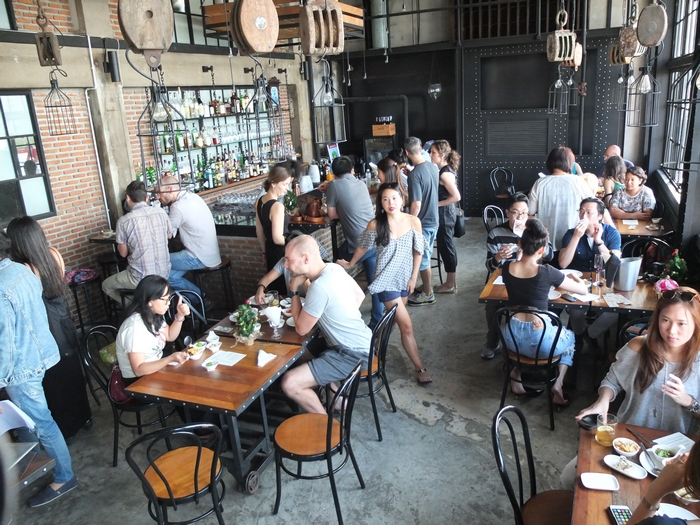Eating bugs is nothing new in Thailand. It’s the selfie that every backpacker longs for when they finally make it to Khaosan, and in certain regions of the country, it’s a daily menu option no different than chicken or pork.
For most Bangkokians, the greatest pleasures in life can be had while enjoying the city’s food. Whether that means picking up some spicy larb moo or pad krapow gai from the food cart on your soi, or selecting a juicy slab of Wagyu fillet steak from your favorite restaurant, the feeling of anticipation as you decide what you’re going to eat is second-to-none.
But how would you feel if, instead of the usual protein sources of chicken, pork, shrimp and tofu, menus were boosted by the presence of silkworms, ants and crickets? For those who have sampled the over-fried and under-flavored scorpions on-a-stick found in stalls throughout Bangkok, the idea is not entirely appealing. For more squeamish eaters, it’s downright terrifying.

Mushroom fritti with silkworm cilantro dip.
However, advocates of low-carbon eating, such as climate change consultant and co-owner of Hazel’s Ice Cream Parlor and Fine Drinks Regan Pairojmahakij, are trying to introduce others to this new sustainable food trend that focuses on eating food that is available locally and can be eaten with minimal processing in order to lower the carbon emissions caused by factory farming, animal grazing and global food transportation.
Low-carbon eating fans point out that, as the global population approaches nine billion, agricultural production will need to increase by 70 percent, and with no sign that we are going to stop having sex once we hit that figure, it’s pretty much guaranteed that the population will continue to increase.

Boiled quail eggs with cashew dukkah and kafir lime leaves.
So while meat, especially beef, is incredibly resource-intensive to produce, insects can provide another source of protein for just one-tenth of the resources. You are likely to see more and more of these ingredients on menus as the world gets serious about sustainability.
The low-carbon eating trend has started to gain traction right here in Bangkok. Focused on the preparation of locally-sourced, seasonal produce and more diverse ingredients than traditional recipes, these dishes limit reliance on expensive imported ingredients in order to lower the carbon footprint of the diner.
At a low-carbon pop-up dinner last month at Sheepshank Public House, which Pairojmahakij helped to organize, there was plenty of this creativity on offer. The event featured creative, low-carbon dishes including wild tree basil pesto, soybean and cricket pasta, capsicum stuffed with job’s tears and local cheese, watermelon salad with black basil and tilapia crumbs, boiled quail eggs with cashew dukkah and kafir lime leaves, and mushroom fritti with silkworm cilantro dip. The event proved that these unlikely ingredients can be adapted into tasty recipes quickly and easily.

Diners at Sheepshank Public House recently enjoying a low-carbon pop-up dinner.
We sampled the dishes, and while they didn’t make us want to chow down on a mountain of silkworms, we could see how they might be incorporated into everyday meals. The cricket pasta, specifically, is a bit chewier and nuttier than semolina pasta and bears some resemblance to whole-wheat pasta.
For fans of more simple fare, such as burgers and hot dogs, there is no reason why bugs can’t be processed into patties, wieners and other more familiar food forms. When you think about it, are the questionable animal parts that purportedly make up the modern hot dog any more appealing than ants or worms?
To put your minds — and stomachs — at rest, low-carbon advocates don’t expect others to radically alter their diets and start chomping on bugs at every meal. But, by returning to a pattern of eating mostly what’s available locally and in-season, it is possible to reduce the carbon footprint of your meals.

Watermelon salad with black basil and tilapia crumbs.
For example, instead of importing the sweetest strawberries from around the world, year-round, fruit fans can look forward to summer, when the berries appear naturally. In this way, people can begin to become excited about seasonal food again.
A side benefit of sticking to regional food is that it much cheaper, since the food hasn’t been shipped across the world to end up at your local Villa Market. It also tends to be far fresher and tastier when it reaches your table.
Though this low-carbon pop-up dinner happened last month, some similar dishes appear on the menu at Seven Spoons if you’d like to try them. Chef Somkiat “Joke” Pairojmahakij, of Seven Spoons, Sheepshank, and Hazel’s, created both menus.





Reader Interactions